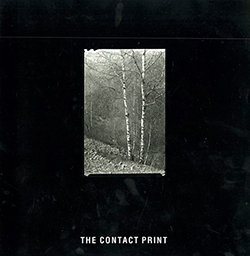1983 – The Contact Print
James Alinder, ed.,
The Friends of Photography, Carmel, California,
1982;
48 pp.; 38 black and white photographs; softcover
The Friends of Photography continues its excellent publication record with the release of The Contact Print, thirtieth in an ongoing series of quarterly journals and major photographic monographs. Edited and with an introduction by James Alinder, this slim but very attractive volume (published to accompany an exhibit at the Friends of Photography Gallery) includes thirty-eight actual size reproductions of large-format contact prints by Harry Callahan, Linda Connor, Emmet Gowin, Nicholas Nixon, Olivia Parker, Michael A. Smith, Frederick Sommer, Josef Sudek, Brett Weston and Minor White. The introduction is adequate and careful; a brief biography of each photographer is included, the reproduction quality is outstanding and the selection of work is generally astute.
Interestingly, Frederick Sommer and Harry Callahan are the real stars of this particular collection. The Sommer reproductions include “The Furies”, 1946; “Ondine”, c. 1950; “Moon Culminations”, 1951; and an untitled collage from 1977. Each image is brilliant and provocative and all are printed with Sommer’s legendary attention to detail and tone value. Every square millimetre of print surface is completely thought-out and totally controlled, representing a level of intellectual complexity and virtuosity of execution that is extraordinary. Sommer may not be “the most important white man in North America”, as he once boasted to a printing assistant, but he certainly is one of the continent’s most important photographers, as is continually evidenced by work such as this. Callahan’s work is less complex but equally meaningful and the effectiveness of the images is not in the least reduced by their familiarity. “Eleanor”, 1947; “Trees, Chicago”, 1950; “Eleanor”, 1952; and “Lake Michigan”, 1953 are included here and each retains its freshness, immediacy and depth of feeling despite the fact that each has been before the public for three decades. It is a particular pleasure to see the famous “Trees, Chicago” and the 1952 “Eleanor” image reproduced full size and with such clarity and vigour.
Several other photographers also play major roles. Josef Sudek is represented by five images, a collection of gentle, sometimes elegiac, photographs, all in different formats. A sampling of Linda Connor’s recent series on petroglyphs and pictographs in the western and southwestern U.S. is included and these photographs combine an interesting quality of contemplation and reflection with a sharp-edged precision (something relatively new for Connor). And Nicholas Nixon’s 8 x 10 studies of people show a grab-shot spontaneity that is remarkable for the format in addition to the expected fine definition.
The Minor White images are a curious selection: the 1946 and 1948 street studies and a mediocre landscape from the “Amputations Series” of 1946 contrast awkwardly with the famous “Sun in Rock, Devil’s Slide”, 1947. Brett Weston’s two images are technically stunning — they were made with an 11 x 14 camera — but are not among his best; and the same criticism could be applied to Emmet Gowin’s work, which has been seen to better advantage (although not better reproduced) in other collections. Michael A. Smith is represented by three landscape photographs, and Olivia Parker by four of the still-life constructions for which she has become known; the work of these photographers is interesting but in each case the selection lacks a certain dynamism.
Any serious large-format photographer should make a point of looking at The Contact Print (available in some bookstores as well as directly from The Friends of Photography in Carmel, California): the best work is inspiring and the collection is intelligent. A confirmed small-format addict might have mixed feelings, but couldn’t help but respond to the elegance, sharpness and resonant tonality of these prints. The great era of view-camera photography may be over but, as this catalogue proves, there is still enough large-format work being done to interest anyone who cares about fine technique and thoughtful seeing.

